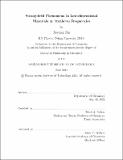Strong-field Phenomena in Low-dimensional Materials at Terahertz Frequencies
Author(s)
Shi, Jiaojian
DownloadThesis PDF (105.4Mb)
Advisor
Nelson, Keith A.
Terms of use
Metadata
Show full item recordAbstract
The advent of terahertz(THz)-frequency laser pulses carrying a substantial fraction of their energy in a single field oscillation cycle has opened a new era in the experimental investigation of strong light-matter interactions in solids, motivated by the quest for the ultimate frontiers of all-optical controls. Exploring ways to approach those frontiers requires insight into the underlying strong-field physics. Meantime, the development of low-dimensional materials with a reduction in at least one dimension has been shown to reveal novel properties beyond those encountered in bulk forms, including the emergence of multi-phase landscapes, collective quantum effects, and topological orders.
This dissertation explores strong-field phenomena in low-dimensional materials driven by strong-field pulsed excitation at THz frequencies. I first introduce the generation and detection of high-field THz and mid-infrared (MIR) pulses. The perplexing strong-field responses of low-dimensional materials urge the implementation of multimodal probe schemes and advanced theoretical frameworks. So I describe three classes of spectroscopic methods to disentangle intricate couplings and complex behaviors under THz-frequency electromagnetic irradiation. Then I elaborate on strong-field theories of non-periodic and periodic systems under oscillating fields.
We have investigated two-dimensional transition metal dichalcogenides (2D TMDs) and zero-dimensional quantum dots (QDs) under electromagnetic excitation at THz frequencies. For 2D TMDs, we have explored a hitherto unobserved Franz-Keldysh effect on exciton resonance in monolayer MoS2 under THz fields. We have demonstrated a metastable topological phase transition in 2D MoTe2, driven by THz-liberated carriers assisted with coherent phonon excitations. Further single-shot measurements reveal evidence of an intermediate phase. For QDs, we have demonstrated THz-driven reemergence of quenched photoluminescence in QDs on gold by suppressing the trion-mediated Auger recombination. By effectively engineering the charge transfer between luminophore systems, we have developed a record-sensitive THz detector and polarimeter via THz-to-visible upconversion. We have investigated crossover between the quantum-mechanical and classical description of light in the QD up-conversion spanning visible, near-infrared, MIR, and THz regimes. With the above knowledge, we have demonstrated an all-optical control of fluorescence blinking in single QDs with MIR pulses by removing excess charges, thereby significantly reducing photoluminescence flicker and achieving near-unity quantum yield even at high excitation flux.
Date issued
2021-06Department
Massachusetts Institute of Technology. Department of ChemistryPublisher
Massachusetts Institute of Technology